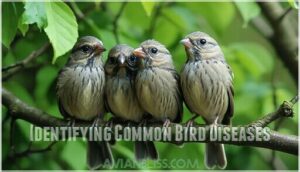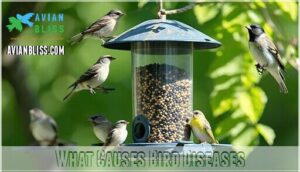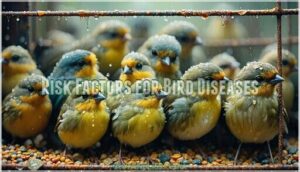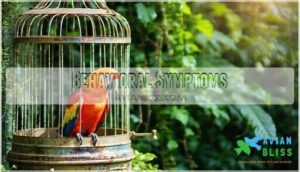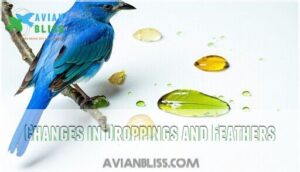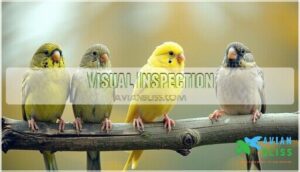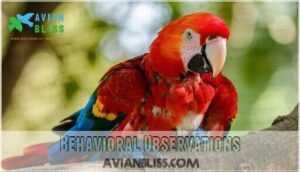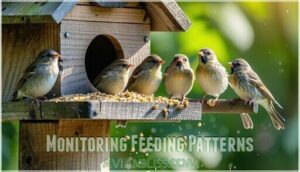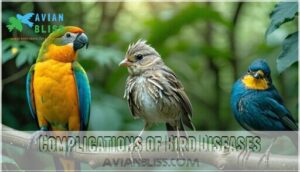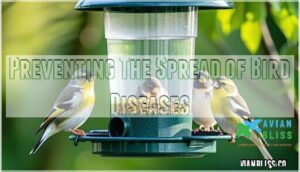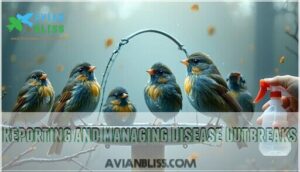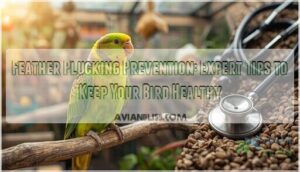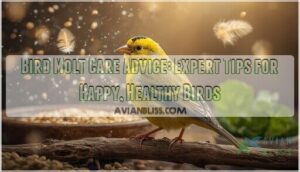This site is supported by our readers. We may earn a commission, at no cost to you, if you purchase through links.
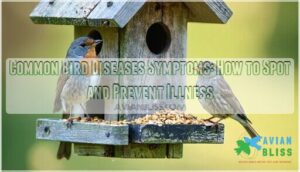 You’ll spot common bird diseases symptoms by watching for ruffled feathers, lethargy, and difficulty perching.
You’ll spot common bird diseases symptoms by watching for ruffled feathers, lethargy, and difficulty perching.
Birds with respiratory infections often wheeze or keep their beaks open while breathing. Eye diseases present as swelling, discharge, or crusty formations around the eyes.
Neurological issues cause disorientation or unusual head positions. Droppings might change consistency or color when a bird is sick.
Like humans fighting a cold, infected birds typically eat less and become less active. Regular cleaning of your feeders is your first line of defense—proper sanitation can prevent these ailments from spreading through your backyard bird community.
Table Of Contents
- Key Takeaways
- Identifying Common Bird Diseases
- What Causes Bird Diseases
- Risk Factors for Bird Diseases
- Common Backyard Bird Diseases
- Symptoms of Bird Infections
- How to Identify Sick Birds
- Complications of Bird Diseases
- Preventing The Spread of Bird Diseases
- Transmission of Bird Diseases to Humans
- Reporting and Managing Disease Outbreaks
- Frequently Asked Questions (FAQs)
- What are the most common diseases in birds?
- What are the signs and symptoms of psittacosis?
- Do backyard birds carry diseases?
- What are the symptoms of bird disease?
- What happens when one catches the bird flu?
- Are sick birds a sign of disease?
- What birds are affected by a bird ailment?
- What diseases do birds carry?
- How do you identify a common backyard bird disease?
- What is the most common disease in birds?
- Conclusion
Key Takeaways
- You’ll recognize sick birds by watching for ruffled feathers, lethargy, and difficulty perching, along with respiratory symptoms like wheezing or open-mouth breathing.
- You should monitor birds for eye problems (swelling, discharge, crusty formations), neurological issues (disorientation, unusual head positions), and changes in droppings and eating habits.
- You’ll prevent disease spread by cleaning feeders weekly with a 10% bleach solution, providing fresh water daily, and offering a variety of healthy foods to support bird immunity.
- You should temporarily remove feeders if you spot sick birds and report unusual symptoms to local wildlife agencies, as early detection can prevent outbreaks in your backyard bird community.
Identifying Common Bird Diseases
Spotting common bird diseases early is key to keeping your feathered friends healthy and safe.
By watching for unusual symptoms like changes in behavior, appetite, or droppings, you can identify potential problems before they get worse, which is crucial for maintaining their health and safety.
Symptoms of Bird Diseases
How can you tell if a bird is falling ill? Watch closely for warning signs.
Here’s your checklist of diagnostic symptoms:
- Dull, ruffled feathers: An early symptom of bird diseases like salmonellosis.
- Eye issues: Swollen or crusty eyes point to House Finch Eye Disease.
- Lethargy or weight loss: Signs of progression toward serious bird illness.
Spot these bird illness symptoms early to help protect wildlife.
When to Look for Bird Diseases
Understanding when to look for bird diseases can help you stop outbreaks early.
Pay close attention during Seasonal Changes, Migration Patterns, the Breeding Season, or Molting Period, as birds face maximum stress.
If you notice bird illness symptoms like reduced appetite, lethargy, or eye discharge—take action.
Early detection, especially during extreme Weather Impacts, keeps your backyard visitors healthy and vibrant!
Types of Bird Diseases
Birds face all kinds of challenges in terms of staying healthy.
Common bird diseases include bacterial infections like psittacosis, viral infections such as bird flu, and fungal or parasitic infections like aspergillosis.
Symptoms of avian illness vary, but here are a few examples to watch for:
- Avian pox: Wart-like growths on featherless areas.
- Salmonellosis: Diarrhea, weakness, and weight loss.
- House Finch Eye Disease: Puffy, crusty eyes.
Birds can also suffer from common bird feather disorders, impacting their plumage and overall health.
What Causes Bird Diseases
Bird diseases often start with contaminated food, water, or close contact with infected birds, making clean environments essential.
Stressful conditions can weaken a bird’s immune system, leaving it more vulnerable to illness.
Contaminated Food and Water Sources
Keep food and water clean to shield birds from illnesses like salmonella and aspergillosis.
Contaminated food and stagnant water attract bacteria, parasites, fungal growth, and even chemical exposure.
- Clean feeders: Bacterial contamination thrives on residue.
- Store food properly: Mold-free food guarantees health.
- Change water often: Fresh water prevents parasite transmission.
A little effort stops bird diseases, keeping feathered friends happy!
Contact With Infected Birds
Shared spaces like feeders and perches can spread infectious diseases faster than gossip at the birdbath.
Direct contact, airborne transmission, fecal exposure, and shared perches are culprits behind bird diseases like avian pox, salmonellosis, and bird flu.
Sick birds spread these zoonotic risks quickly.
Spot bird disease symptoms early, isolate ill birds, and disinfect shared areas to break the cycle of transmission.
Stressful Environments
Stress can skyrocket bird disease risks, just like too much noise ruins a good nap.
Bird stress often stems from crowding effects or captivity stress, making them vulnerable to illness.
Environmental changes like habitat loss or noise pollution disrupt rest and routines, while pesticide exposure harms food sources.
- Factors driving stress include:
- Habitat loss reducing shelter
- Noise pollution interrupting rest
- Climate shifts altering habitats
- Scarce, unhealthy food
- Captivity stress impacting behavior
Risk Factors for Bird Diseases
Your bird’s health can take a hit when basic care is neglected, especially in areas like cleanliness and diet.
Crowded spaces, poor sanitation, and weakened immune systems create the perfect storm for diseases to spread.
Poor Sanitation and Hygiene
A little mess can mean big problems for your feathered friends.
Poor hygiene boosts bird disease risks. Regular waste removal, feeder hygiene, and bird cage hygiene are non-negotiable.
Use bird disinfectants on perches and bird utensils to limit disease load. Standing water? Banish it—it’s a magnet for contamination!
Spotless gear reduces water contamination and keeps birds healthier. Prioritize bird hygiene, or you might find your backyard turning into a bird flu nightclub!
Overcrowding and Close Proximity
When feeders are spotless, think about space.
Birds packed tightly, like concertgoers, face higher disease transmission and immune suppression risks.
Close quarters boost stress levels and resource competition, triggering health issues and altering social behavior.
Spread feeders apart and limit crowding, giving birds space to thrive.
Good spacing reduces bird diseases and improves bird hygiene while supporting healthy populations.
Weakened Immune Systems
A bird’s immune system can weaken due to nutritional deficiencies, environmental stressors, or genetic predisposition, leaving it open to infections.
Common bird disease risk factors include:
- Immunosuppressive diseases that reduce their natural defenses.
- Secondary infections when their system’s already struggling.
- Age—young and old birds are more vulnerable.
- Overcrowded habitats, increasing exposure to germs.
- Poor stress management, impacting overall health.
Support your feathered friends by reducing stress and ensuring high-quality care—it’s prevention, not perfection!
Poor Nutrition and Malnutrition
A poorly balanced diet is a silent risk to birds, often masking Dietary Deficiencies that lead to Vitamin Imbalances and serious issues like Metabolic Disorders or Organ Failure.
Relying on Seed-Only Diets deprives birds of essential nutrients like vitamin A, protein, and calcium, leading to bird nutrition deficiencies.
To prevent these issues, offer a bird balanced diet that includes fresh fruits, vegetables, and high-quality pellets.
Watch for signs like bird vitamin A deficiency or weakness, and consider supplements for variety.
Proper feeding guarantees healthier, happier birds.
Common Backyard Bird Diseases
You mightn’t realize it, but common backyard bird diseases can spread quickly among feathered visitors at your feeders.
By recognizing symptoms like unusual droppings or lethargy early, you can help protect your local bird population and maintain a safe, healthy environment.
Avian Pox
Avian pox, caused by poxvirus, appears as wart-like lesions on birds’ bare skin, often near beaks and legs.
These growth stages signal infection, while pox transmission vectors include contact with contaminated surfaces.
Though there’s no cure, avian pox treatment focuses on supportive care.
Use pox prevention methods like cleaning feeders regularly and reducing overcrowding.
Spotting symptoms early helps protect birds from worsening bird diseases, utilizing effective disease management.
Salmonellosis
Salmonella transmission often starts with contaminated feeders or droppings, creating high songbird susceptibility during winter outbreaks.
Salmonellosis in birds can cause diarrhea, lethargy, and puffed-up feathers.
Without preventative measures like disinfecting feeders or cleaning spilled seeds, this bacterial infection spreads fast.
Antibiotic treatments exist but are limited, so it’s essential to prioritizing hygiene to curb devastating bird diseases this season, and by doing so, you can protect your backyard birds.
House Finch Eye Disease
House Finch Eye Disease, caused by Mycoplasma gallisepticum, often presents as swollen eyes and crusty patches (Finch Conjunctivitis).
You’ll notice affected birds experiencing lethargy or respiratory distress. Disease transmission spreads through close contact.
Treatment options include isolating sick birds and sanitizing feeders regularly. Prevention strategies, like maintaining hygiene, reduce risks and protect bird populations from Mycoplasmal Conjunctivitis.
Stay vigilant and ensure the health of the birds by understanding that Mycoplasma gallisepticum is a key factor in the disease.
West Nile Virus
West Nile Virus (WNV) spreads through mosquito vectors, heavily impacting birds and humans.
Infected birds, especially corvids, show symptoms like lethargy, bird respiratory distress, tremors, or blindness. Sadly, most die swiftly.
Bird immunity varies, but regional prevalence depends on mosquito activity.
Protect bird populations by reducing stagnant water where mosquitoes breed, safeguarding against this dangerous bird disease with far-reaching human impact.
Prevention’s key!
Trichomoniasis
Trichomoniasis, also called Pigeon Canker or Frounce, targets birds’ upper digestive tracts.
Look for symptoms like oral secretions, weight loss, and swallowing struggles. The infection spreads through contaminated bird feeders and water sources.
- Watch for Symptoms: Beak deformities, drooling.
- Transmission Routes: Shared feeders, oral secretions.
- Preventative Measures: Clean feeders regularly; provide balanced food.
Symptoms of Bird Infections
You can spot bird infections by watching for physical changes like puffed feathers, nasal discharge, or irregular droppings.
Noticing unusual behaviors, like sitting still for long periods or reduced appetite, can also help you identify early signs of illness.
You can also consider irregular droppings as a sign of infection in birds.
Physical Symptoms
Spotting physical symptoms in birds helps you catch illnesses early. Look for feather abnormalities, like patchy feather loss or discolored patches. Birds showing eye discharge or swollen eyes might be battling infections.
Pay attention to breathing difficulty—signs like open-mouth breathing or tail bobbing often signal respiratory distress birds face. Beak issues can also arise, and discoloration and cracks may indicate an underlying infection.
Other red flags include lesions/growths on the skin and noticeable weight changes. Keep feeding stations clean because dirty feeders can spread diseases, including bird flu.
Here’s a quick reference:
| Symptom | Possible Cause | Why It’s Serious | Bird Flu Link? |
|---|---|---|---|
| Feather Loss | Parasites/Fungal | Limits warmth, flight | Rare |
| Eye Discharge | Infection | Blocks vision | Potential |
| Breathing Issues | Respiratory Disease | Can cause suffocation | Yes |
| Lesions | Viral or Bacterial | Spreads via surfaces | Rare |
Behavioral Symptoms
Noticing something unusual in your bird’s behavior? Watch for these behavioral signs of illness:
- Lethargy signs: Birds becoming inactive or unusually still.
- Appetite changes: Loss of appetite in birds can hint at underlying issues.
- Social withdrawal: Isolation from flocks or ignoring interactions raises red flags.
- Feather plucking: A stressed or unwell bird may start damaging its feathers.
Additional indicators like sudden silence, strange vocalization changes, or unusual bird behavioral problems may suggest illness. Recognizing these subtle signs can protect your feathered friends and prevent further risks.
Changes in Droppings and Feathers
Changes in your bird’s droppings and feathers can signal trouble.
Watch for droppings that shift in consistency or color—diarrhea or odd hues might mean illness. Feather loss, unusual molting, or dull, ruffled feathers are red flags too.
Here’s a quick reference:
| Symptom | What to Watch For | Potential Cause |
|---|---|---|
| Dropping Consistency | Watery or too firm | Gastrointestinal issue |
| Feather Loss | Bald patches or excess molting | Skin infection/disease |
| Color Changes | Green/yellow droppings or feathers | Infection or malnutrition |
Regular checks and quick action can save your bird’s health!
How to Identify Sick Birds
You can spot sick birds by observing their behavior, appearance, and feeding habits closely.
Spot sick birds early by observing their unique behaviors, physical changes, and feeding habits—small signs reveal big health concerns.
Look for signs like unusual stillness, fluffed feathers, or a lack of appetite, as these often indicate underlying health issues, specifically unusual stillness.
Visual Inspection
A sick bird often shows its troubles through appearance.
Watch for Feather Abnormalities like dull plumage, feather loss, or bald spots.
Inspect the beak for discoloration or unusual growth.
Swollen eyes or Eye Discharge, diarrhea birds, and Lesion Identification on legs or feet are warning signs.
A slouched or weak posture could signal bird flu symptoms or lethargy birds needing attention.
Behavioral Observations
Once you’ve looked at your bird’s appearance, pay attention to their behavior.
Activity levels are a big clue—are they more lethargic or less playful than usual? Shifts in vocalizations, like sudden silence or unfamiliar sounds, can indicate discomfort.
Changes in social interactions, such as avoiding flockmates or your company, might suggest they’re unwell.
Watch for repetitive actions like feather plucking, which may signal stress or illness.
Appetite changes, whether eating less or none at all, are red flags, especially if paired with lethargy or diarrhea.
Birds can’t tell us how they feel, but their actions speak volumes. Stay alert to subtle shifts, and trust your instincts on bird symptoms.
Monitoring Feeding Patterns
Pay attention to feeding frequency. Birds skipping meals or showing food intake changes might indicate weight loss or appetite issues like bird anorexia.
Watch for odd seed preferences or abrupt bird weight loss.
Keep feeders clean and stock fresh seed to prevent illness.
Social feeding behavior shifts, like birds eating alone, can signal health concerns, including issues related to weight loss.
Complications of Bird Diseases
Bird diseases can lead to serious complications like malnutrition, weight loss, and organ damage if left untreated.
Recognizing these issues early gives you the chance to prevent long-term harm and keep your feathered friends healthy.
Malnutrition and Weight Loss
Spotting malnutrition in birds can be tricky, but bird weight loss, feather loss, or bird emaciation might signal trouble.
Dietary deficiencies may lead to muscle wasting, bird lethargy, and even metabolic disorders.
Loss of appetite in birds is common, too.
Regularly weigh your bird—small changes matter! A balanced diet protects against malnutrition, keeping them healthy and preventing bird anorexia.
Don’t wing it—feed wisely to prevent malnutrition and ensure your bird stays healthy, avoiding issues like bird anorexia.
Organ Damage and Failure
Organ damage, like liver failure or kidney damage, can quietly develop when birds face malnutrition or disease.
Be wary of bird liver problems, kidney failure, and even heart complications—they often announce themselves subtly.
Watch for signs like feather loss or beak deformities, indicating potential lung infections or digestive issues.
Bird renal problems, including visceral and articular gout, can cause irreversible harm.
Stay proactive with proper nutrition and hygiene.
Consider flu vaccination to reduce risks and engage in tracking programs to monitor disease outbreaks effectively, using proper nutrition.
Preventing The Spread of Bird Diseases
You can protect birds by keeping their feeders and water sources clean, fresh, and free of contaminants.
Regularly removing spills and debris helps prevent bacteria and viruses from spreading among your feathered visitors.
Cleaning and Disinfecting Feeders
To help stop bird diseases, clean feeders regularly based on Feeder Material.
Wash with hot water, scrubbing off debris, and use safe Cleaning Solutions. Disinfection Frequency matters—weekly is great during outbreaks.
For specialized needs, consider exploring options for effective bird feeder.
Handle feeders with gloves for Safe Handling. Air-dry completely to Prevent Mold.
These steps keep bird feeders clean, reduce symptoms, and support effective disease prevention in your backyard.
Providing Fresh and Clean Water
Fresh water is like a health tonic for birds, helping them thrive. Contaminated water, though, can be a breeding ground for bird diseases.
Here’s how to keep their water safe and inviting:
- Change water daily to reduce bacteria buildup.
- Opt for safe water source options, like filtered or rainwater.
- Monitor the cleaning frequency, scrubbing bird baths weekly to remove debris.
In winter, consider using a bath to prevent freezing. Small tips, such as adding electrolyte solutions or safe water additives, go a long way in promoting bird health and disease prevention.
Offering a Variety of Healthy Foods
Just as clean water keeps birds hydrated, offering a diverse menu supports their health.
Mix up seed variety to meet nutritional needs and prevent vitamin deficiency. Add supplement options like fruits or mealworms for foraging enrichment, encouraging natural behavior.
A balanced diet strengthens immunity and reduces bird appetite loss. Consider offering a high quality blend for ideal nutrition.
To avoid loss of appetite in birds, replace stale food frequently. Think of it as a community café, where freshness keeps everyone coming back.
Managing Spills and Debris
Switching to keeping things tidy, managing spills and debris is key to preventing bird diseases.
Leftover food and waste can lead to contaminated foods, attracting pests or spreading symptoms among birds. Proper bird health sanitation is essential to minimize these risks.
Stick to safe practices:
- Safe Disposal: Toss spoiled seeds daily.
- Routine Cleaning: Scrub bird baths and feeders weekly.
- Spill Prevention: Place feeders on stable surfaces.
- Debris Impact: Rake under feeders often for healthier surroundings.
Transmission of Bird Diseases to Humans
Some bird diseases can jump from birds to humans, posing serious health risks if you’re not careful.
By understanding how illnesses like salmonellosis and West Nile virus spread, you can protect yourself and your feathered friends.
Avian Pox and Salmonellosis
Spotting signs of Avian Pox or Salmonella in backyard birds isn’t a guessing game.
Avian Pox rarely harms humans, but Salmonella can infect through droppings. Keep surroundings clean and watch for symptoms like weakness or abnormal behavior.
Unchecked disease co-occurrence boosts mortality rates.
| Bird Disease | Symptoms | Risk to Humans |
|---|---|---|
| Avian Pox | Warty growths | Low |
| Salmonella | Lethargy, diarrhea | Moderate (via droppings) |
| Co-occurring Infections | Severe weakness | Varies |
Stay vigilant—safe birds mean safer environments!
West Nile Virus and Trichomoniasis
West Nile Virus and Trichomoniasis can impact both birds and humans, making awareness essential.
For WNV prevention, focus on these steps:
- Eliminate standing water to reduce mosquito disease vectors.
- Monitor bird illness signs, like uncoordinated movements.
- Practice safe handling of bird feeders and droppings due to zoonotic potential.
- For Trichomoniasis treatment, maintain clean water sources and support bird immunity naturally, which is crucial for overall prevention.
Precautions and Safety Measures
Keeping safe from bird diseases starts with proper hygiene.
Wash your hands often, especially after handling feeders or cleaning droppings.
Use bird disinfectants and follow strict hygienic methods to sanitize feeders, bird utensils, and surfaces regularly.
Wear gloves and protective equipment when cleaning to avoid direct contact.
When possible, practice quarantine procedures by observing sick birds separately.
Safe handling and following biosecurity measures, like avoiding touching wild birds or their droppings, help minimize risks.
Disinfection protocols are essential—don’t overlook them.
Prevention, including bird vaccination when appropriate, guarantees healthier birds and less worry for you.
Reporting and Managing Disease Outbreaks
If you notice signs of disease in your backyard birds, you’ll need to report it promptly to wildlife authorities.
You can help manage outbreaks by temporarily removing feeders, thoroughly disinfecting all bird-related equipment, and documenting cases to assist health officials in tracking the transmission patterns, which will help prevent further spread.
Contacting Wildlife Rehabilitators and Veterinarians
When you discover a sick bird, three critical steps can connect you with proper avian veterinary care. Finding qualified help quickly improves recovery chances.
- Don’t wait until it’s too late—birds often hide illness until critically sick
- Each moment matters when dealing with fragile avian patients
- The right expert can mean the difference between life and death
Contact wildlife rehabilitators with specialized bird training first—they understand wild species’ unique needs. For pet birds, seek avian vets with bird-specific medical expertise.
In emergency situations, call ahead to confirm they accept birds, as not all veterinarians have avian experience. Consider cost considerations early; wildlife rehab centers often operate on donations, while avian specialists might charge more than standard vets.
Local resources like bird clubs can provide trusted referrals.
Reporting to Local Wildlife Agencies
Five key wildlife agencies depend on your disease reporting to track bird illness outbreaks effectively.
When you spot sick birds, promptly share this essential data using official reporting protocols.
Most agencies offer simple online forms or hotlines for public cooperation.
Include specific symptoms, location, and number of affected birds to aid disease surveillance.
Your information contributes to important data sharing networks that protect wild bird populations.
Find agency contact info through your state’s wildlife department website – your cooperation creates stronger prevention systems for everyone’s backyard birds, which is crucial for wild bird populations.
Isolating Sick Birds and Stopping Feeding
When you spot a sick bird, isolation becomes your first defense against disease spread.
Implement proper quarantine protocols by immediately stopping feeding in that area and safely relocating feeders. Thoroughly disinfect bird feeders and baths with a 10% bleach solution.
These steps substantially reduce spread while supporting bird rehabilitation efforts. Remember, temporary feeding suspension is sometimes necessary to break the cycle of bird diseases and protect your feathered visitors.
Consistent sanitation is key to avian influenza prevention, and it plays a crucial role in disease prevention.
Frequently Asked Questions (FAQs)
What are the most common diseases in birds?
Birds battle bacterial, viral, and fungal foes frequently.
You’ll find psittacosis, avian pox, and candidiasis commonly affecting your feathered friends.
Salmonellosis and aspergillosis round out these top threats that can compromise your bird’s health.
What are the signs and symptoms of psittacosis?
You’ll notice signs of psittacosis including swollen eyes, lethargy, weight loss, breathing difficulties, nasal discharge, and watery green droppings.
It’s highly contagious, requiring immediate veterinary care as it can affect humans too, which makes immediate veterinary care crucial.
Do backyard birds carry diseases?
Yes, your backyard visitors can carry diseases like salmonellosis, avian pox, and psittacosis. You’ll want to maintain clean feeders and baths to reduce transmission risks between birds and to humans.
What are the symptoms of bird disease?
Over 70% of bird diseases share common symptoms. You’ll notice fluffed feathers, lethargy, discharge from eyes or nostrils, labored breathing, weight loss, and unusual droppings when your feathered friends are ill.
What happens when one catches the bird flu?
You’ll experience flu-like symptoms including fever, cough, and muscle aches.
In severe cases, respiratory complications can develop.
Seek medical attention immediately if you’ve had contact with infected birds and develop these severe symptoms, especially if you notice respiratory complications.
Are sick birds a sign of disease?
Sick birds often indicate disease through physical and behavioral signs.
You’ll notice lethargy, fluffed feathers, discharge from eyes/nostrils, or difficulty breathing.
Don’t ignore these warning signs—they’re nature’s way of signaling trouble.
What birds are affected by a bird ailment?
From songbirds to parrots, from doves to finches, multiple species face avian ailments. You’ll find that psittacosis affects hookbills, conjunctivitis targets house finches, and salmonellosis strikes many backyard visitors year-round.
What diseases do birds carry?
Birds can carry bacterial diseases like psittacosis and salmonellosis, viral infections including avian pox and West Nile virus, and fungal problems such as candidiasis.
You’ll want to watch for respiratory issues, lethargy, and unusual droppings, which can be indicative of the diseases mentioned, highlighting the importance of monitoring for lethargy.
How do you identify a common backyard bird disease?
Look for listless, lethargic birds with visible symptoms: fluffed feathers, difficulty breathing, discharge from eyes/nose, unusual droppings, crusty growths, or difficulty perching.
You’ll need to monitor your feeders closely for these telltale signs.
What is the most common disease in birds?
Among wild birds, you’ll commonly encounter avian pox and salmonellosis, particularly in songbirds at feeders.
For pet birds, psittacosis (parrot fever) remains the most prevalent bacterial infection you’ll need to watch for.
Conclusion
Remarkably, over 60% of wild bird deaths result from preventable diseases.
By recognizing common bird diseases symptoms early—ruffled feathers, lethargy, unusual droppings—you’ll help protect your feathered visitors.
Remember to clean feeders weekly with a 10% bleach solution, provide fresh water daily, and temporarily remove feeders if you spot sick birds.
Your vigilance creates a healthier ecosystem for birds and enhances your birdwatching experience with thriving, vibrant wildlife in your backyard, promoting a healthier ecosystem.

